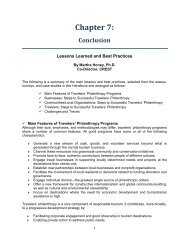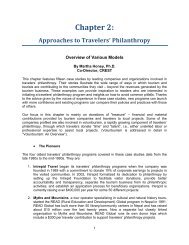Travelers' Philanthropy Handbook - Center for Responsible Travel
Travelers' Philanthropy Handbook - Center for Responsible Travel
Travelers' Philanthropy Handbook - Center for Responsible Travel
You also want an ePaper? Increase the reach of your titles
YUMPU automatically turns print PDFs into web optimized ePapers that Google loves.
• Origins of <strong>Travel</strong>ers’ <strong>Philanthropy</strong>The earliest philanthropic traveler is the Good Samaritan in the Bible. The Good Samaritan wasthe traveler who helped the poor and suffering he met along the way, strangers he might neversee again. How do we translate ancient Good Samaritanism into modern travelers’ philanthropy<strong>for</strong> the good of people and nature along the road?Despite the numbers and money in global tourism, it has its dark side: the demand <strong>for</strong> cheapflights and cheap vacations has seen the travel industry cut costs to the bone. Larger visitornumbers must make up the thinner profit margins. The difference in wealth and cost of living isprovided momentum <strong>for</strong> visitor flows from rich to poor countries because it is inexpensive tovacation in those locations. The combination of mass tourism and economic differential leads topaltry incomes, high social costs, and often adverse environmental impact <strong>for</strong> developingcountries.On the bright side, the poor countries will have a market advantage <strong>for</strong> the conceivable future,particularly if they can offer greater benefits and lower costs. This is where the ecotourismprinciples come in, and where the philanthropic traveler can add far more than fees, standards,and fair trade practices can exact.How can the benefits of ecotourism be amplified by travelers’ philanthropy? How canecotourism plus travelers’ philanthropy help to redress the dark side of global travel?• Changing Sensibilities of VisitorsTourist concerns about rights, justice and fairness,and about bettering the lot of local people andwildlife, have grown in the last decade. Theseconcerns stem from the ecotourism movementand media coverage. The ecotourism principles,standards, and policies and the new sensibilitiesof today’s responsible traveler are reshapingglobal tourism. As a result, the benefits of tourismare rising and downside falling <strong>for</strong> third worlddestinations.In the slipstream of travelers flow benefits that arefar less visible than revenues. Donor countriestend to give aid and support to nations visited bytheir citizens. Visitors and donors alike seepoverty, lack of social services, and injustice. Their concern and support makes a difference tothe pace of development. These are not benefits commonly attributed to tourism, but theyshould be. One man, Edmund Hillary, devoted his life to building schools and health clinics inNepal after his ascent of Everest. Tens of thousands of other benevolent if less adventuroustravelers have donated time and money to development. There is yet another less obviousslipstream effect: where tourists go, businesses and non-government organizations follow.I want to stress the word “responsible”. The ecotourist is, above all, the responsible tourist whoaims to do good <strong>for</strong> people, places, and nature. Our intention was to use the sensibilities ofvisitors to create a movement <strong>for</strong> better tourism, rather than have a donor or conservation14Maasai guide and tourist, Kenya.Credit: David Western















